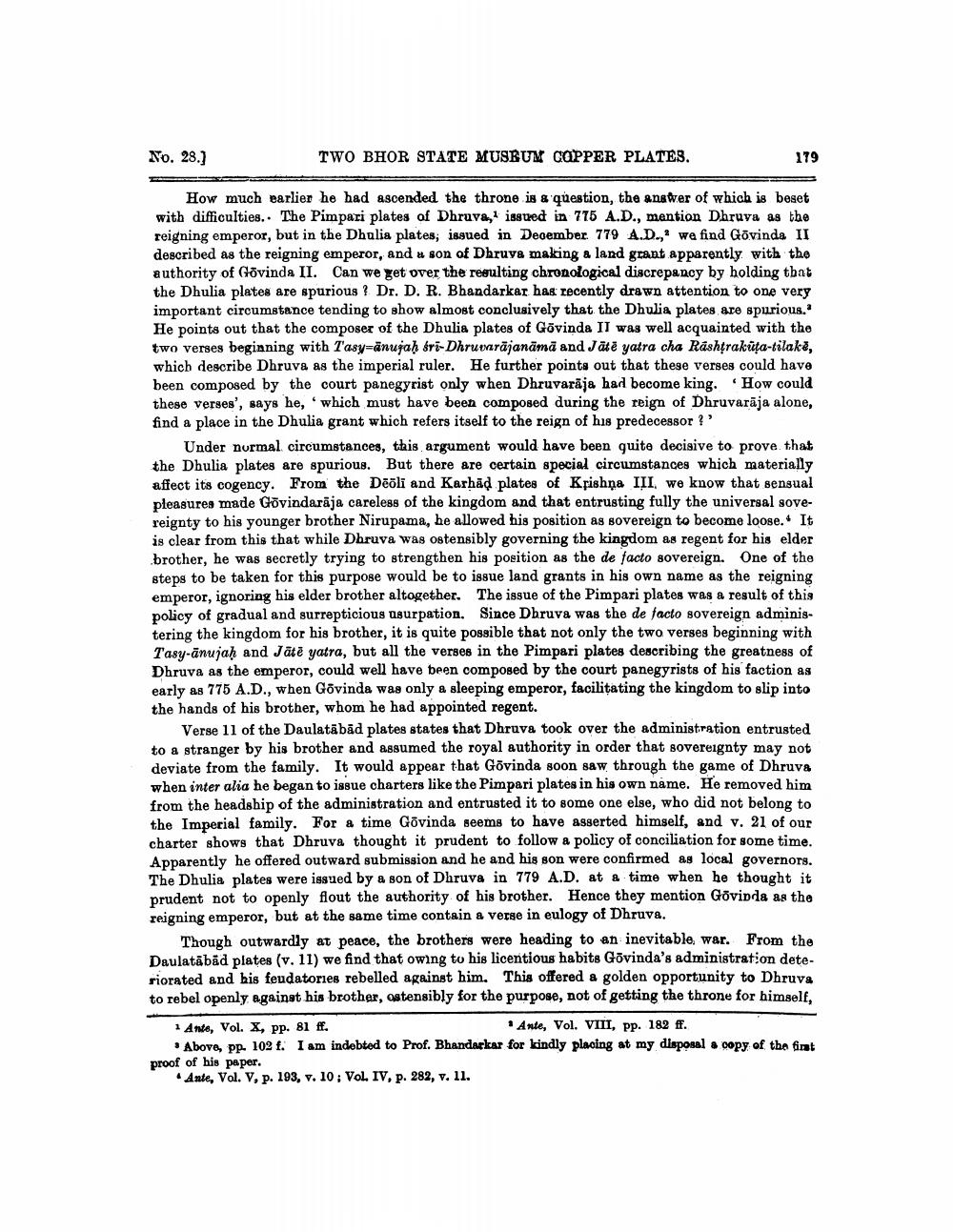________________
No. 28.]
How much earlier he had ascended the throne is a question, the answer of which is beset with difficulties. The Pimpari plates of Dhruva, issued in 775 A.D., mention Dhruva as the reigning emperor, but in the Dhulia plates; issued in December 779 A.D., we find Govinda II described as the reigning emperor, and a son of Dhruva making a land grant apparently with the authority of Govinda II. Can we get over the resulting chronological discrepancy by holding that the Dhulia plates are spurious? Dr. D. R. Bhandarkar has recently drawn attention to one very important circumstance tending to show almost conclusively that the Dhulia plates are spurious. He points out that the composer of the Dhulia plates of Govinda II was well acquainted with the two verses beginning with Tasy-anujaḥ śrī-Dhruvarajanāmā and Jātē yatra cha Rashtrakuta-tilake, which describe Dhruva as the imperial ruler. He further points out that these verses could have been composed by the court panegyrist only when Dhruvaraja had become king. How could these verses', says he, which must have been composed during the reign of Dhruvaraja alone, find a place in the Dhulia grant which refers itself to the reign of his predecessor?'
6
TWO BHOR STATE MUSEUM COPPER PLATES.
179
Under normal circumstances, this argument would have been quite decisive to prove that the Dhulia plates are spurious. But there are certain special circumstances which materially affect its cogency. From the Deōli and Karhad plates of Krishna III, we know that sensual pleasures made Govindaraja careless of the kingdom and that entrusting fully the universal sovereignty to his younger brother Nirupama, he allowed his position as sovereign to become loose. It is clear from this that while Dhruva was ostensibly governing the kingdom as regent for his elder brother, he was secretly trying to strengthen his position as the de facto sovereign. One of the steps to be taken for this purpose would be to issue land grants in his own name as the reigning emperor, ignoring his elder brother altogether. The issue of the Pimpari plates was a result of this policy of gradual and surrepticious usurpation. Since Dhruva was the de facto sovereign administering the kingdom for his brother, it is quite possible that not only the two verses beginning with Tasy-anujaḥ and Jātē yatra, but all the verses in the Pimpari plates describing the greatness of Dhruva as the emperor, could well have been composed by the court panegyrists of his faction as early as 775 A.D., when Govinda was only a sleeping emperor, facilitating the kingdom to slip into the hands of his brother, whom he had appointed regent.
Verse 11 of the Daulatābād plates states that Dhruva took over the administration entrusted to a stranger by his brother and assumed the royal authority in order that sovereignty may not deviate from the family. It would appear that Govinda soon saw through the game of Dhruva when inter alia he began to issue charters like the Pimpari plates in his own name. He removed him from the headship of the administration and entrusted it to some one else, who did not belong to the Imperial family. For a time Govinda seems to have asserted himself, and v. 21 of our charter shows that Dhruva thought it prudent to follow a policy of conciliation for some time. Apparently he offered outward submission and he and his son were confirmed as local governors. The Dhulia plates were issued by a son of Dhruva in 779 A.D. at a time when he thought it prudent not to openly flout the authority of his brother. Hence they mention Govinda as the reigning emperor, but at the same time contain a verse in eulogy of Dhruva.
Though outwardly at peace, the brothers were heading to an inevitable, war. From the Daulatabad plates (v. 11) we find that owing to his licentious habits Govinda's administration deteriorated and his feudatories rebelled against him. This offered a golden opportunity to Dhruva to rebel openly against his brother, ostensibly for the purpose, not of getting the throne for himself,
1 Ante, Vol. X, pp. 81 ff.
Ante, Vol. VIII, pp. 182 ff.
Above, pp. 102 f. I am indebted to Prof. Bhandarkar for kindly placing at my disposal a copy of the first proof of his paper.
Ante, Vol. V, p. 193, v. 10; Vol. IV, p. 282, v. 11.




